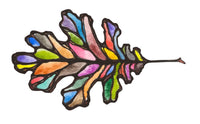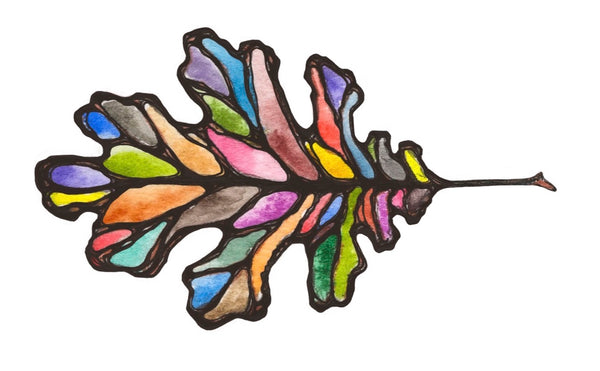
And Ode To Green Earth (And Why You Should Be Using It)
Green Earth, also more commonly known as Terre Verte, is in most paint lines, though it is one of the most commonly overlooked (and underrated) colors.
In use since at least the wee years A.D., Green Earth is beautiful, natural, plentiful, and non-toxic.

Combination Swatch of our Italian Green Earth - See our Overview of Pigments here.
So, why is it so often overlooked?
The simple answer is that is has a low tinting strength and high transparency, which are not the same. (You can read more about those are here.) The longer answer is that, in general, people do not have as strong an understanding of art materials these days. When art became divorced from science as it diverged from realistic representation with the invention of photography, and as art supplies began to be mass produced, artists could forgo the previous necessity of having an intimate understanding of their materials, and indeed many fine art schools teach very little about them, instead placing most emphasis on concept development.
Many people who encounter Green Earth will give it a spin and quickly conclude it is "of low quality" or that "it sucks" because they either do not understand what tinting strength is or they have conflated it with quality/pigment load. Our Green Earth has an absolute maximum pigment load, and carries the same pigment concentration as powerhouses such as Lamp Black and Violet Hematite. It just has very different handling characteristics.
This error in understanding partially stems from a common belief that "color" is somehow constant or elemental (such as the idea that there is a "true red"). On the contrary, there are many pigments that fit within the red category, and each color is a chemical substance the reflects different combinations of lightwaves. Because each pigment has a different chemical formula, different crystalline structure, different density, etc, they not only reflect light differently, they also have different handling properties and different color expression (tinting strength and transparency fit into this category).
There is truly no way to talk in any meaningful way about art materials without chatting briefly about science, however I will try to keep it light and readable. (I adore geology, but I will admit it takes a very special author to keep me awake while I read about it.)

Monochrome painting I did of a tomato leaf using only our Italian Green Earth.
What Is Tinting Strength?
This is a very important watercolor characteristic to understand.
When mixing colors, you'll find that some "take over" the mixture very quickly after only adding a very little amount - these are colors with a high or intense tinting strength. Colors that leave you feeling like you have to keep adding more and more and more to make any visible difference in the mixture have a low tinting strength. Colors that have to be built up slowly in layers to get any kind of saturation have a low tinting strength, while colors that you feel like you constantly need to water down or lift out have an intense tinting strength.
Tinting strength is different from how quickly a color re-wets. It has more to do with a color's speed of buildability, how it looks right out of the gate, and how it acts in color mixtures.
Out of the gate, Green Earth is a whisper whereas Phthalocyanine Green is a bellow. Green Earth needs encouragement where Phthalo. Green needs restraint.
Low Tinting Strength Is Not "Bad"
Watercolor characteristics do not occur on scales of good or bad, success or failure. It is best to think of them as personality traits. I translate the opposite ends of the spectrum of tinting strength into Introversion (low tinting strength) and Extroversion (high tinting strength). Neither are good or bad - they are just traits that help make up the complex mosaic of a person. It is the same with the colors in your palette.
I like to think of color characteristics as extra tools for your chest. They give you a framework to understand the pigments you use. By understanding which pigments display which characteristics, you can deploy your colors with more precision, expertise, and creativity. Understanding characteristics helps you choose the right tool for the job, more or less.
So, let's give Green Earth a break and start appreciating it for what it is: a gorgeous natural green with a weak tinting strength.

Value Scale Swatch of our Italian Green Earth - See all of our color's Value Scales here.
A Little Bit More About Green Earth
Green Earth is very plentiful in nature, occurring in abundance on nearly every continent. Some of the most famous sources are near Verona, Italy and from Cypress.
Green earth receives its color from the green minerals Glauconite and Celadonite. They occur in different amounts and ratios, along with a variety of other accessory earths and minerals to give each Green Earth a distinctive terrior, depending on the location of its source.
While Green Earth was not a popular choice in early cave paintings (likely because its extreme transparency made it difficult to discern on a rock wall), it gradually gained in popularity, especially as an underpainting to flesh. Many portraits and nudes have an underpainting of Green Earth, as it helped neutralize red tones and give the effect of translucence. (It is the same reason the cosmetics industry offers green bases to dial down the appearance of rosacea).

Why Green Earth Is In Every Single Watercolor Set I Have
Not even kidding. I even enjoy using it for monochrome paintings. I adore it on its own and always as part of an ensemble.
So, why do I love it so?
It is buildable. In other words: it has a low tinting strength. Indeed, this is one of the reasons I hold it dear. Watercolors are painted light to dark, intensifying as you go. So, buildable colors are very intuitive to paint with (while colors that have high tinting strengths and require caution and restraint can feel more fussy). I can use soft, subtle washes of it to map out my painting and then gradually build up leisurely layers as I develop volume and detail
Green Earth has the perfect hue. Right off the pan is matches landscapes and foliage. For this reason, I consider Green Earth a "base color". I use base colors (usually natural Ochre and Earth pigments) as the foundation of most of my color mixtures, tweaking them with only very small amounts of higher chroma historical or synthetic colors. Add a dash of Orange Ochre to Green Earth to temper it to a later-summer green. Add a pinch of Quinoxalinedione Yellow for a more sun-soaked spring green. A swipe of Phthalocyanine Green will deepen it and punch up the chroma. But Green Earth is a pigment you can splash all over your landscape, using other colors to pull it in the direction you need.
Harmony. The fact that Green Earth is a natural pigment and mimics natures greens so readily gives painting landscapes with it a kind of harmony. Many natural pigments can give this feeling, which is one of many reasons why painting with them is so special.
Ultimately, The Most Important Thing Is To Choose Colors You Love
Your palette should bring you joy and inspiration, and it should contain the colors you want in your work. Customizing your palette (which you can learn how to do here) is part of the creative journey, and everyone's will be different (both journey and palette).
The point of this post is not to tell you that YOU should have Green Earth in your palette, but rather to help you understand it better so that you can more accurately assess whether it should be part of your collection.
And... I'm just tired of hearing people snub and insult one of history's most beautiful pigments.
As always, wishing you happy painting!


